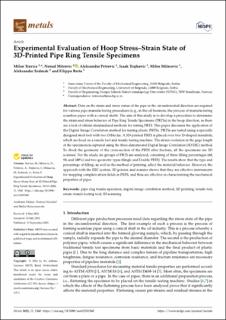| dc.description.abstract | Data on the strain and stress status of the pipe in the circumferential direction are required for various pipe manufacturing procedures (e.g., in the oil business, the process of manufacturing seamless pipes with a conical shaft). The aim of this study is to develop a procedure to determine the strain and stress behavior of Pipe Ring Tensile Specimens (PRTSs) in the hoop direction, as there are a lack of official standardized methods for testing PRTS. This paper discusses the application of the Digital Image Correlation method for testing plastic PRTSs. PRTSs are tested using a specially designed steel tool with two D blocks. A 3D-printed PRTS is placed over two D-shaped mandrels, which are fixed on a tensile tool and tensile testing machine. The strain evolution in the gage length of the specimens is captured using the three-dimensional Digital Image Correlation (3D DIC) method. To check the geometry of the cross-section of the PRTS after fracture, all the specimens are 3D scanned. For the study, six groups of PRTS are analyzed, consisting of three filling percentages (60, 90, and 100%) and two geometry types (Single and Double PRTS). The results show that the type and percentage of filling, as well as the method of printing, affect the material behavior. However, the approach with the DIC system, 3D printer, and scanner shows that they are effective instruments for mapping complete strain fields in PRTS, and thus are effective in characterizing the mechanical properties of pipes. | en_US |

